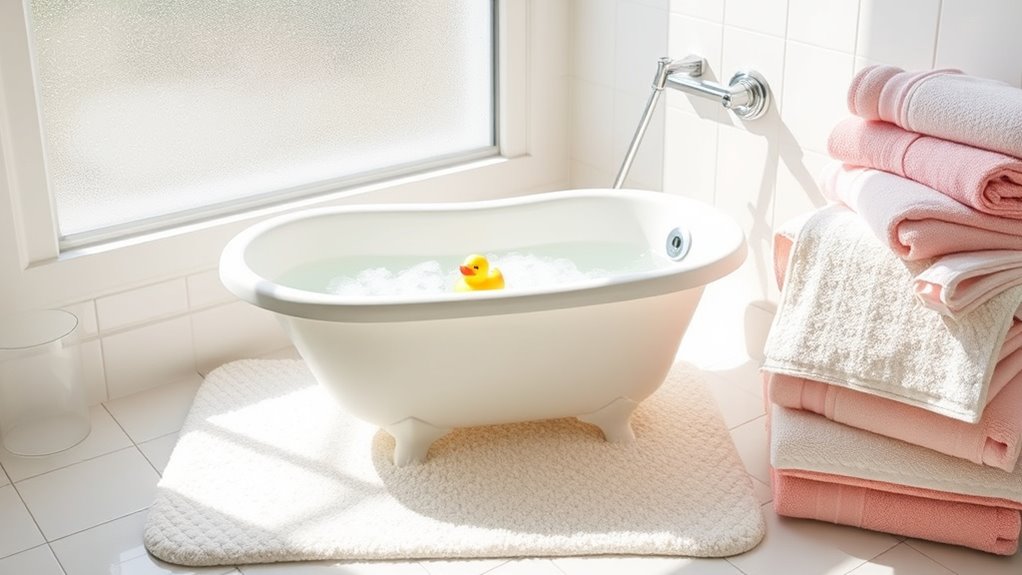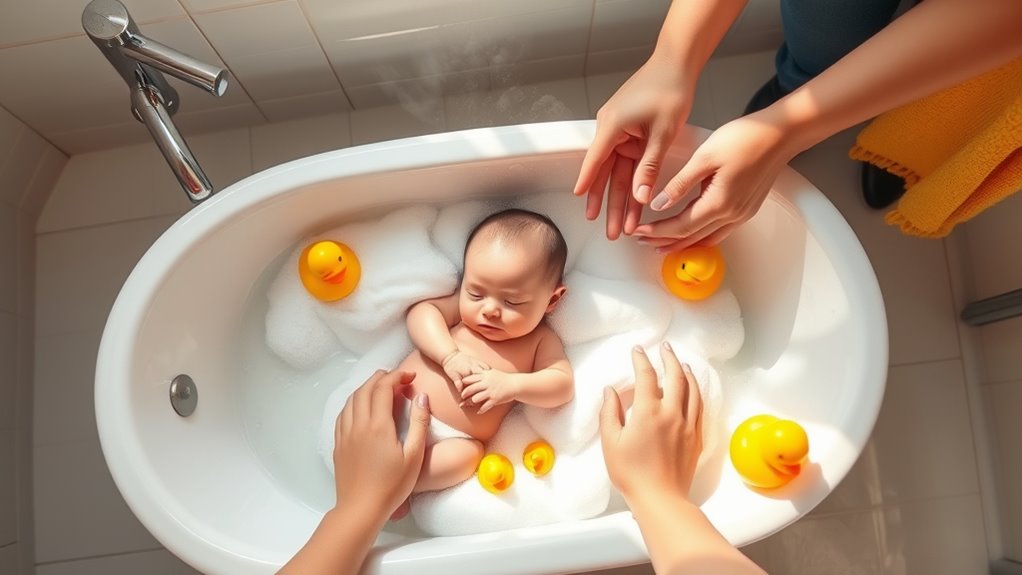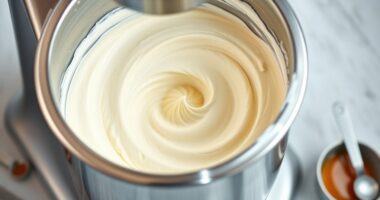To keep your baby safe during bath time, always use slip-resistant mats inside and outside the tub. Install non-slip pads on the tub bottom for traction, and keep the bathroom floor dry to prevent slips. Make sure the water temperature is safe, and always check it before placing your baby in the tub. Remember, direct supervision is crucial, even with bath seats. There’s so much more to ensure a safe bathing experience for your little one.
Key Takeaways
- Use slip-resistant mats inside and outside the bathtub to minimize the risk of slipping during bath time.
- Apply non-slip pads or decals to the tub’s bottom for added traction while the baby is bathing.
- Keep the bathroom floor dry and clear of water to prevent falls and slippery surfaces.
- Ensure the bathroom is warm to keep the baby comfortable and reduce the risk of accidents.
- Always supervise the baby closely, as slips can happen quickly even in minimal water.

When it comes to bath time, safety is paramount for your little one. Infants under one year old account for a staggering 80% of bathtub drownings. This statistic underscores their vulnerability, making your supervision essential during these moments. Drowning can happen quickly and quietly, often in as little as one inch of water. Therefore, you should always keep your child within arm’s reach to prevent any accidents.
You might think it’s safe to let an older sibling watch over a younger child, but relying on them isn’t wise. Their lack of maturity can lead to dangerous situations. Even when using bath seats or rings, don’t let your guard down. These products aren’t foolproof, and you should always supervise your child directly. First-time parents often recognize the dangers of unsupervised bathing, but it’s crucial that all caregivers remain vigilant.
To prevent slips and falls, make your bathroom as safe as possible. Use slip-resistant mats both inside and outside the bathtub to reduce the risk of accidents. Applying non-slip pads or decals to the bottom of the tub can provide additional traction. It’s also vital to keep the bathroom floor clear of water to prevent slipping, and installing a spout cover can protect your child from hitting their head on the faucet.
Don’t forget to keep the bathroom warm to ensure your child stays comfortable after bathing. Water temperature is another critical factor. Set your water heater to 120°F or less to prevent scalding. Always check the water temperature with your wrist or elbow before placing your child in the tub. Fill the tub with water first and then place your baby inside, ensuring the water level is low—about 2-4 inches—for infants. Swirling the water can help prevent hot spots and ensure a consistent temperature throughout.
Babyproofing the bathroom is equally important. Use cabinet locks to keep medications and electrical items out of reach, and install toilet locks to prevent falls. Keep electrical appliances away from water to avoid electrical injuries, and secure any loose items that could block the drain or cause accidents.
Lastly, while bath seats and rings might seem convenient, they don’t guarantee safety. Always ensure any seat used is securely attached to the tub, and never rely on them alone. Ultimately, educating yourself and others about bath safety can make a significant difference. Be proactive about awareness and consider learning CPR for emergencies. Your vigilance can help keep your little one safe during bath time.
Frequently Asked Questions
What Age Can My Baby Start Sitting in the Tub?
Your baby can start sitting in the tub around 6 to 7 months old when they can sit up independently.
At this stage, they’re more stable, making bath time safer and more enjoyable.
However, always supervise your baby during baths, as they can still slip or lose balance.
Using a baby tub or sink is a great option until they’re ready for a full bathtub, ensuring a safer bathing experience for your little one.
How Often Should I Bathe My Baby?
You should bathe your baby about 2-3 times a week. This frequency helps maintain cleanliness without drying out their delicate skin.
Infants under 6 months don’t need daily baths; instead, spot cleaning during diaper changes is usually enough. Overbathing can lead to irritation, so it’s best to keep it minimal.
Just ensure you’re using mild cleansers and keeping the bath environment warm and comfortable for your little one.
Are There Specific Bath Toys Safe for Infants?
When choosing bath toys for infants, focus on safety, durability, and fun.
Look for toys made from non-toxic materials, like natural rubber or recycled plastics. Opt for designs without holes to prevent mold growth. Brands such as Green Toys and Oli&Carol offer excellent options.
Ensure the toys are age-appropriate and encourage imaginative play.
What Temperature Should the Water Be for a Baby’s Bath?
For your baby’s bath, aim for a water temperature between 98.6°F and 100.4°F (37°C to 38°C). This range ensures a comfortable and safe experience.
To check the temperature, use a bath thermometer, or test it with your elbow or wrist for a more accurate feel. Always remember, water that’s too hot can scald your baby, so double-check before you place them in the tub.
Keeping the bath short helps maintain their comfort too.
Can I Use Soap and Shampoo on My Newborn?
Did you know that over 60% of parents are unsure about using soap and shampoo on their newborns?
You should avoid using traditional soaps and shampoos, as they often contain harsh chemicals that can irritate your baby’s sensitive skin. Instead, opt for gentle, organic products specifically designed for newborns.
Always use small amounts and ensure you rinse thoroughly to prevent any residue. Keeping your baby’s skin safe should be your top priority during bath time.
Conclusion
In conclusion, keeping bath time safe for your baby is crucial. Always keep one hand on your little one, and consider using a non-slip mat to prevent slips. For instance, imagine a scenario where a parent momentarily turns away to grab a towel, only to return and find their baby slipping. By taking these precautions, you can ensure a fun and safe bath experience, letting you focus on making memories rather than worrying about accidents.









